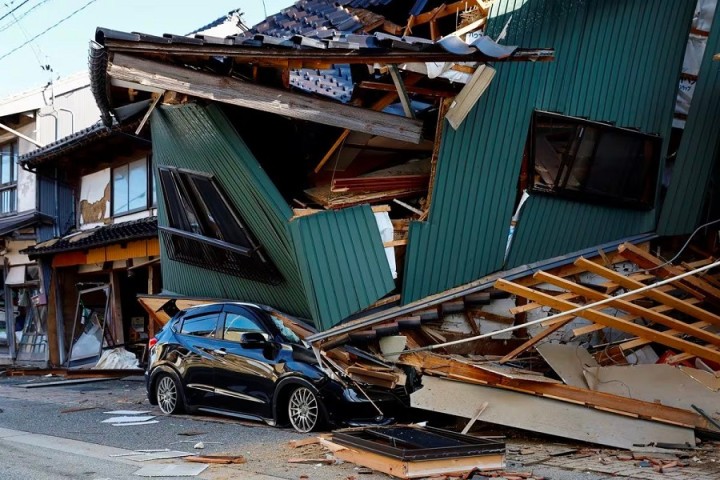Japan quake: Rescuers rush to reach survivors

The quake with a preliminary magnitude of 7.6 struck in the middle of the afternoon on Monday, prompting residents in some coastal areas to flee to higher ground as tsunami waves hit Japan’s west coast, sweeping some cars and houses into the sea.
Thousands of army personnel, firefighters and police officers from across the country have been dispatched to the worst-hit area in the Noto peninsula in Ishikawa prefecture.
However, rescue efforts have been hindered by badly damaged and blocked roads and authorities say they are finding it difficult to assess the full extent of the fallout.
Many rail services, ferries and flights into the area have been suspended. Noto airport has closed due to damage to its runway, terminal and access roads, with 500 people stranded inside cars in its parking lot.
“The search and rescue of those impacted by the quake is a battle against time,” Prime Minister Fumio Kishida said during an emergency disaster meeting on Tuesday.
Kishida said rescuers were finding it very difficult to reach the northern tip of the Noto peninsula due to wrecked roads, and that helicopter surveys had discovered many fires and widespread damage to buildings and infrastructure.
More than 20 people have already died and many more are trapped in collapsed buildings, several news outlets reported citing local authorities.
Japan’s fire and disaster management agency has only confirmed six deaths but said it had received reports of many more victims with no vital signs. Firefighters have been battling blazes in several cities and freeing people from quake wreckage, it said.
More than 140 tremors have been detected since the quake first hit on Monday, according to the Japan Meteorological Agency. The agency has warned more strong shocks could hit in the coming days.
Wrecked homes
Nobuko Sugimori, a 74-year-old resident of Nanao city in Ishikawa, told Reuters she had never experienced such a quake before.
“I tried to hold the TV set to keep it from toppling over, but I could not even keep myself from swaying violently from side to side,” Sugimori said from her home which had a large crack down its front wall and furniture scattered around the inside.
Across the street, a car was crushed under a collapsed building where residents had another close call.
Fujiko Ueno, 73, said nearly 20 people were in her house for a New Year celebration when the quake struck but miraculously all emerged uninjured.
“It all happened in the blink of an eye” she said, standing in the street among debris from the wreckage and mud that oozed out of the road’s cracked surface.
Several world leaders sent condolence messages with President Joe Biden saying in statement the United States was ready to provide any necessary help to Japan.
“Our thoughts are with the Japanese people during this difficult time,” he said.
The Japanese government ordered around 100,000 people to evacuate their homes on Monday night, sending them to sports halls and school gymnasiums, commonly used as evacuation centres in emergencies.
Many returned to their homes on Tuesday as authorities lifted tsunami warnings.
But around 33,000 households remained without power in Ishikawa prefecture early on Tuesday morning after a night where temperatures dropped below freezing, according to Hokuriku Electric Power’s website. Most areas in the northern Noto peninsula also have no water supply, NHK reported.
The Imperial Household Agency said it would cancel Emperor Naruhito and Empress Masako’s slated New Year appearance on Tuesday following the disaster. Kishida postponed his New Year visit to Ise Shrine scheduled for Thursday.
Japan’s defence minister told reporters on Tuesday that 1,000 army personnel are currently involved in rescue efforts and that 10,000 could eventually be deployed.
Nuclear plants
The quake comes at a sensitive time for Japan’s nuclear industry, which has faced fierce opposition from some locals since the 2011 earthquake and tsunami that triggered nuclear meltdowns in Fukushima. Whole towns were devastated in that disaster.
Japan last week lifted an operational ban imposed on the world’s biggest nuclear plant, Kashiwazaki-Kariwa, which has been offline since the 2011 tsunami.
The Nuclear Regulation Authority said no irregularities were found at nuclear plants along the Sea of Japan, including five active reactors at Kansai Electric Power’s Ohi and Takahama plants in Fukui Prefecture.
Hokuriku Electric’s Shika plant, the closest to the epicentre, has also been idled since 2011. The company said there had been some power outages and oil leaks following Monday’s jolt but no radiation leakage.
The company had previously said it hoped to restart the reactor in 2026.
Chip equipment maker Kokusai Electric said it is investigating further after finding some damage at its factory in Toyama ahead of the planned resumption of operations on Thursday.
Companies including Sharp, Komatsu and Toshiba have been checking whether their factories in the area have been damaged.

